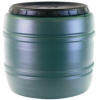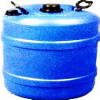Potassium Bromide BP USP, ACS Reagent Grade and Potassium Iodide BP USP IP, FCC Food, ACS Reagent Grade Manufacturers
MSDS of Potassium Bromide
Potassium Bromide USP
KBr 119.0, CAS Number 7758-02-3
Potassium Bromide contains not less than 98.0 percent and not more than 100.5 percent of KBr, calculated on the dried basis. It contains no added substances.
Appearance of solution: clear and colorless.
Test solution: Dissolve 10.0 g in carbon dioxide-free water, and dilute with the same solvent to 100 mL.
Identification:
A: A solution containing 4.5 mg of potassium bromide responds to the test for Bromide.
B: Responds to the test for Potassium.
Acidity or alkalinity: To 10 mL of the solution prepared for the test for Appearance of solution, add 0.1 mL of bromothymol blue TS: not more than 0.5 mL of 0.01 N hydrochloric acid or 0.01 N sodium hydroxide is required to change the color of this solution.
Loss on drying: Dry it at 100 to 105 for 3 hours: it loses not more than 1.0% of its weight.
Bromates:
Starch–mercuric iodide solution: Triturate 1.0 g of soluble starch with 5 mL of water and pour the mixture into 100 mL of boiling water, containing 10 mg of mercuric iodide.
Procedure: To 10 mL of the solution prepared for the test for Appearance of solution add 1 mL of Starch–mercuric iodide solution, 0.1 mL of a 100 g per L solution of potassium iodide, and 0.25 mL of 0.5 M sulfuric acid. Allow to stand protected from light for 5 minutes: no blue or violet color develops.
Limit of chlorine: not more than 0.6%.
Iodides: To 5 mL of the solution prepared for the test for Appearance of solution add 0.15 mL of a 10.5 g per 100 mL ferric chloride solution, and 2 mL of dichloromethane. Shake, and allow to separate. The lower layer is colorless.
Sulfates: A 2.0-g portion shows no more sulfate than corresponds to 0.2 mL of 0.020 N sulfuric acid (0.01%).
Limit of iron: not more than 20 ppm.
Magnesium and alkaline-earth metals: (0.02%, calculated as Ca).
Heavy metals: not more than 10 ppm.
Potassium Bromide BP
DEFINITION
Content: 98.0 per cent to 100.5 per cent (dried substance).
CHARACTERS
Appearance: White or almost white, crystalline powder or colourless crystals.
Solubility: Freely soluble in water and in glycerol, slightly soluble in alcohol.
IDENTIFICATION
A. It gives reaction of bromides.
B. Solution S (see Tests) gives the reactions of potassium.
TESTS
Solution S: Dissolve 10.0 g in carbon dioxide-free water R prepared from distilled water R and dilute to 100 ml with the same solvent.
Appearance of solution: Solution S is clear and colourless.
Acidity or alkalinity: To 10 ml of solution S add 0.1 ml of bromothymol blue solution R1. Not more than 0.5 ml of 0.01 M hydrochloric acid or 0.01 M sodium hydroxide is required to change the colour of the indicator.
Bromates: To 10 ml of solution S add 1 ml of starch solution R, 0.1 ml of a 100 g/l solution of potassium iodide and 0.25 ml of 0.5 M sulphuric acid and allow to stand protected from light for 5 min. No blue or violet colour develops.
Chlorides: Maximum 0.6 per cent.
Iodides: To 5 ml of solution S add 0.15 ml of ferric chloride solution and 2 ml of methylene chloride.
Shake and allow to separate. The lower layer is colourless.
Sulphates: Maximum 100 ppm.
Iron: Maximum 20 ppm.
Magnesium and alkaline-earth metals: Maximum 200 ppm, calculated as Ca.
Heavy metals: Maximum 10 ppm.
Loss on drying: Maximum 1.0 per cent, determined on 1.000 g by drying in an oven at 105C for 3h.
Potassium Bromide ACS Analytical Reagent
KBr
Formula Wt 119.00
CAS Number 7758-02-3
REQUIREMENTS
Assay: 99.0% KBr
pH of a 5% solution: 5.0-8.8 at 25C
MAXIMUM ALLOWABLE
Insoluble matter: 0.005%
Bromate (BrO3): 0.001%
Iodate (IO3): 0.001%
Chloride (Cl): 0.2%
Iodide (I): 0.001%
Nitrogen compounds (as N): 0.005%
Sulfate (SO4): 0.005%
Barium (Ba): 0.002%
Heavy metals (as Pb): 5 ppm
Iron (Fe): 5 ppm
Calcium (Ca): 0.002%
Magnesium (Mg): 0.001%
Sodium (Na): 0.02%
Potassium Iodide USP
KI -- 166.00
Potassium iodide -- CAS Number 7681-11-0
Potassium Iodide contains not less than 99.0 percent and not more than 101.5 percent of KI, calculated on the dried basis.
Identification: A solution of it meets the requirements of the tests for Potassium and for Iodide.
Alkalinity: Dissolve 1.0 g in 10 mL of water, and add 0.1 mL of 0.1 N sulfuric acid and 1 drop of phenolphthalein TS: no color is produced.
Loss on drying: Dry it at 105C for 4 hours: it loses not more than 1.0% of its weight.
Iodate: Dissolve 1.1 g in sufficient ammonia- and carbon dioxide-free water to obtain 10 mL of solution, and transfer to a color-comparison tube. Add 1 mL of starch TS and 0.25 mL of 1.0 N sulfuric acid, mix, and compare the color with that of a control containing, in a similar volume, 100 mg of Potassium Iodide, 1 mL of standard iodate solution [prepare by diluting 1 mL of potassium iodate solution (1 in 2500) with water to 100 mL], 1 mL of starch TS, and 0.25 mL of 1.0 N sulfuric acid. Any color produced in the solution of the test specimen does not exceed that in the control: not more than 4 µg per g is found.
Limit of nitrate, nitrite, and ammonia: To a solution of 1 g in 5 mL of water contained in a test tube of about 40-mL capacity add 5 mL of 1 N sodium hydroxide and about 200 mg of aluminum wire. Insert a pledget of purified cotton in the upper portion of the test tube, and place a piece of moistened red litmus paper over the mouth of the tube. Heat the test tube and its contents in a steam bath for 15 minutes: no blue coloration of the paper is discernible.
Thiosulfate and barium: Dissolve 0.5 g in 10 mL of ammonia- and carbon dioxide-free water, and add 2 drops of 2 N sulfuric acid: no turbidity develops within 1 minute.
Heavy metals: Dissolve 2.0 g in 25 mL of water: the limit is 0.001%.
Assay: Dissolve about 500 mg of Potassium Iodide, accurately weighed, in about 10 mL of water, and add 35 mL of hydrochloric acid. Titrate with 0.05 M potassium iodate VS until the dark brown solution which is produced becomes pale brown. Add 2 to 3 drops of amaranth TS, and continue the titration slowly until the red color just changes to yellow. Each mL of 0.05 M potassium iodate is equivalent to 16.60 mg of KI.
Potassium Iodide BP (Ph Eur)
KI -- 166.0 -- CAS Number 7681-11-0
Content: 99.0 per cent to 100.5 per cent (dried substance).
CHARACTERS
Appearance: White or almost white powder or colourless crystals.
Solubility: Very soluble in water, freely soluble in glycerol, soluble in ethanol (96 per cent).
IDENTIFICATION
A. Solution S (see Tests) gives the reactions of iodides (2.3.1).
B. Solution S gives the reactions of potassium (2.3.1).
TESTS
Solution S: Dissolve 10.0 g in carbon dioxide-free water R prepared from distilled water R and dilute to 100 ml with the same solvent.
Appearance of solution: Solution S is clear and colourless.
Alkalinity: To 12.5 ml of solution S add 0.1 ml of bromothymol blue solution R1. Not more than 0.5 ml of 0.01 M hydrochloric acid is required to change the colour of the indicator.
Iodates: To 10 ml of solution S add 0.25 ml of iodide-free starch solution R and 0.2 ml of dilute sulphuric acid R and allow to stand protected from light for 2 min. No blue colour develops.
Sulphates: Maximum 150 ppm.
Dilute 10 ml of solution S to 15 ml with distilled water R.
Thiosulphates: To 10 ml of solution S add 0.1 ml of starch solution R and 0.1 ml of 0.005 M iodine. A blue colour is produced.
Iron: Maximum 20 ppm.
Dilute 5 ml of solution S to 10 ml with water R.
Heavy metals: Maximum 10 ppm.
12 ml of solution S complies with test A. Prepare the reference solution using lead standard solution (1 ppm Pb) R.
Loss on drying: Maximum 1.0 per cent, determined on 1.00 g of previously powdered substance by drying in an oven at 105C for 3 h.
POTASSIUM IODIDE IP
KI -- Mol. Wt. 166.00
Category: Antithyroid; antifungal; expectorant.
Description: Colourless crystals or white powder; odourless
Solubility: Very soluble in water; freely soluble in glycerin; soluble in ethanol (95%).
Potassium Iodide contains not less than 99.0 per cent and not more than 100.5 per cent of KI, calculated with reference to the dried substance.
Identification: A 10% w/v solution in carbon dioxide-free water (solution A) gives the reactions of potassium salts and of iodides.
Alkalinity: To 10 ml of solution A add 0.2 ml of 0.01M sulphuric acid; no colour is produced on addition of a drop of phenolphthalein solution. .
Clarity and colour of solution: Solution A is clear and colourless.
Arsenic: Dissolve 5.0 g in 50 ml of 'water and 12 ml of stannated hydrochloric acid AsT. The resulting solution complies with the limit test for arsenic (2 ppm).
Heavy metals: Not more than 10 ppm, determined on 2.0 g
Iron: Solution A complies with the limit lest for iron (20 ppm).
Barium: Dissolve 0.5 g in 10 ml of water and add 1 ml of dilute sulphuric acid; no turbidity develops within one minute.
Potassium Iodide FCC Food Grade
KI Formula wt 166.00
CAS Number 7681-11-0
DESCRIPTION
Potassium Iodide occurs as hexahedral crystals, either transparent and colorless or somewhat opaque and white, or as a white, granular powder. It is stable in dry air but slightly hygroscopic in moist air. One gram is soluble in 0.7 mL of water at 25°, in 0.5 mL of boiling water, in 2 mL of glycerin, and in 22 mL of alcohol.
Function: Nutrient.
REQUIREMENTS
Identification:
A. A 1:10 aqueous solution responds to the tests for Potassium and for Iodide.
B. The pH of a 1:20 aqueous solution is between 6 and 10.
Assay: Not less than 99.0% and not more than 101.5% of KI after drying.
Iodate: Not more than 4 mg/kg.
Lead: Not more than 4 mg/kg.
Loss on Drying: Not more than 1%.
Nitrate, Nitrite, and Ammonia: Passes test.
Thiosulfate and Barium: Passes test.
Potassium Iodide ACS AR Analytical Reagent Grade Chemical
KI -- Formula Weight 166.00
CAS Number 7681-11-0
REQUIREMENTS
Assay: Minimum 99.0% KI
pH of a 5% solution: 6.0-9.2 at 25C
MAXIMUM ALLOWABLE
Insoluble matter: 0.005%
Loss on drying at 150C: 0.2%
Chloride and bromide (as Cl): 0.01%
Iodate (IO3): 3 ppm
Nitrogen compounds (as N): 0.001%
Phosphate (PO4): 0.001%
Sulfate (SO4): 0.005%
Barium (Ba): 0.002%
Heavy metals (as Pb): 5 ppm
Iron (Fe): 3 ppm
Calcium (Ca): 0.002%
Magnesium (Mg): 0.001%
Sodium (Na): 0.005% |



